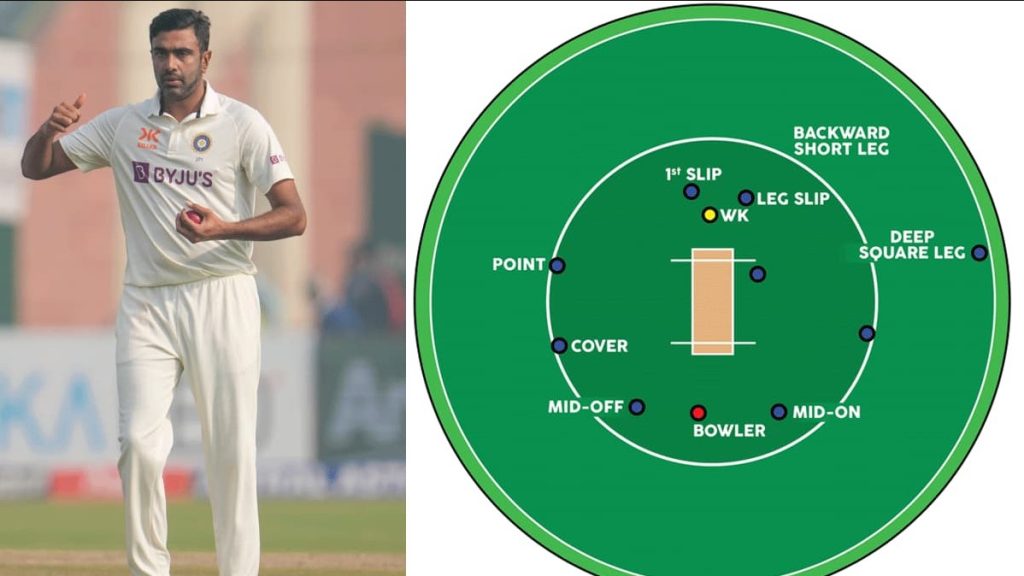Test Match Field Setup: In Test cricket, a well-thought-out field setup can be the difference between taking wickets or conceding runs. Unlike limited-overs cricket, where field placements are more aggressive and often geared towards quick wickets or containment, a Test match field setup is more nuanced and requires a strategic blend of defensive and attacking positions. With a longer format giving bowlers more time to work their magic, field placements are adjusted not just to counter the batsman’s strengths but also to exploit his weaknesses over time.
Test Match Field Setup
In this article, we’ll break down the various field setups for both fast bowlers and spinners, how they evolve during a Test match, and the importance of adaptability and reading the game to set the perfect field for each scenario.
1. Understanding the Basics: The Role of the Captain and Field Setup
The field setup in a Test match is highly dependent on the conditions, the type of bowler, the nature of the batsman at the crease, and the phase of the game. A captain’s ability to make quick adjustments, based on the situation, is crucial. Here are the two main components of a field setup:
- Defensive Field: Typically used when a bowler is trying to contain runs or when the batsman is in solid form, often seen during the early phases of an innings or when the ball is old.
- Attacking Field: Used when a bowler is in a wicket-taking rhythm, when the batsman is vulnerable, or when the team needs quick breakthroughs (e.g., after a break or in the final session of a day).
2. Field Setup for Fast Bowlers
Fast bowlers, particularly those relying on swing or seam movement, often benefit from a traditional Test match field. A typical setup for fast bowlers focuses on building pressure and inducing errors like an edge or a mistimed shot.
Ideal Field for Swing or Seam Bowlers:
- Slip Fielders (First, Second, Third Slip): The slip cordon is critical for fast bowlers. The closer the fielder, the more likely they are to intercept an edge that doesn’t carry directly to the keeper. The first slip is usually the most important and should be placed close to the keeper (about 2–3 yards away), with others spaced out accordingly.
- Gully: The gully is positioned behind the square on the off side, and it’s used to catch balls that are edged but don’t carry to the slips.
- Short Leg and Leg Gully: For fast bowlers, having a short leg or leg gully on the leg side can catch the batsman off guard if they play a loose shot. This is often used in aggressive, attacking fields, particularly when there’s a chance of a top edge or a defensive shot resulting in a catch.
- Point, Cover, Mid-Off, and Mid-On: These positions vary based on the bowler’s line and length, but they serve to cut off singles and stop any potential boundary shots. A bowler will often have a wide mid-off to catch a potential edge flying through the air.
- Fine Leg and Third Man: These fielders are placed deep to prevent boundaries off the edge or off the bat. They also serve as a safety net for aerial shots that don’t carry to the slips.
- Bowling Length: A fast bowler’s field is largely dictated by their line and length. For an attacking line, the slips and gully come into play more. For a more defensive or tight line, the placement of cover and mid-off becomes crucial.
Attacking Setup for Fast Bowlers:
An attacking field setup for fast bowlers may look like this:
- 2–3 slips, gully, short leg for a short-pitched delivery.
- Deep square leg, fine leg for cutting off hooks or pulls.
- Mid-on and mid-off close in for the drive, with mid-off deep to catch the lofted shots.
In this configuration, the focus is on inducing mistakes through aggressive shot-making, while the bowler aims for a fuller length, often looking for the edge or the LBW.
Defensive Setup for Fast Bowlers:
- 5–6 fielders on the boundary and a mid-on, mid-off to contain the batsman, especially if they’re settled and playing well.
- Wide slips and a long-on to restrict boundary options, while a deep third man and deep cover protect against the drive or upper cut.
3. Field Setup for Spinners
Spinners, particularly those who rely on turn and bounce, need a more precise field setup to create pressure. In Test matches, spin bowlers often need time and patience to extract the maximum value from the pitch, and their field placements are crucial to restricting the batsman’s options and forcing a mistake.
Ideal Field for Spinners:
- Slip Fielders (First and Second Slip): Just like fast bowlers, spinners often rely on getting the edge. The field is set with slips positioned closer to the batsman for the outside edge that might not carry directly to the wicketkeeper.
- Short Leg: This is one of the most important positions for spinners. A batsman playing the ball off the front foot can be caught at short leg, especially when a bowler is spinning the ball in on a turning pitch. For off-spinners, the short leg position is critical, while left-arm spinners may use a short leg on the off side.
- Forward Short Leg: Sometimes used by captains to close down any loose shots and apply more pressure.
- Cover, Point, and Mid-Off: These fielders are particularly crucial when the batsman is looking to drive the ball through the offside. In spin bowling, the primary goal is to prevent runs and induce a mistake. The close-in fielders can help trap batsmen who misjudge the turn of the ball.
- Deep Mid-On, Deep Mid-Off, Long On, and Long Off: These positions help protect against the lofted drives or pulls that can go for boundaries.
- Deep Square Leg and Fine Leg: These positions are important when there’s a risk of the batsman playing an aerial sweep or pull shot.
Attacking Setup for Spinners:
An attacking field setup for a spinner usually has:
- 1–2 slips, short leg, and silly point.
- Cover, mid-off, and point placed relatively close to prevent the drive.
- Deep mid-on and deep square leg to catch any aerial shots.
The bowler’s primary objective is to use flight and drift to force the batsman into committing to a shot, either through edges or leading to a stumping or a catch.
Defensive Setup for Spinners:
- Deep fielders on the boundary line, such as deep square leg, deep cover, and deep mid-off, are used to cut off boundary options.
- Slip fielders might be reduced to just one or two depending on the batsman’s approach, while long-on and long-off are placed deep to prevent overambitious shots.
- The idea in a defensive setup is to contain runs while waiting for the batsman to make an error under pressure.
4. The Importance of Flexibility and Adaptability
The most effective Test match field setup is one that is dynamic and changes according to the game situation. While it is important to have a general idea of field placements for each bowler, a captain and bowlers must be prepared to adapt based on the following:
- The Batsman’s Strengths and Weaknesses: If a batsman is particularly strong on the offside, the captain may position additional fielders on the onside. Alternatively, if a batsman is known for playing aggressive shots, the field may be adjusted to restrict their options.
- Pitch Conditions: If the pitch is flat with little bounce or turn, the field might be more defensive. If the pitch is offering swing, seam movement, or turn, the captain may opt for a more attacking field.
- Stage of the Game: In the final sessions of a Test match or during the dying stages of a Test, field placements become more aggressive. During a fast bowler’s spell at the end of the day, for example, there may be more slips and gully, looking for an edge that could end the match or set up the final breakthrough.
Mastering the Test Match Field Setup
Fielding in a Test match is as much a part of the mental game as it is a physical one. The field setup must be flexible, adapted to each bowler, the batting lineup, and the conditions at play. From fast bowlers to spinners, the right field can make the difference between a breakthrough and a boundary. By reading the game, understanding the strengths and weaknesses of both teams, and adapting the field strategy throughout the match, a captain can create the pressure needed to force mistakes and take crucial wickets in the battle that is Test cricket.
Also Read: Mastering the Art of Fast Bowling: Key Variations and Techniques













